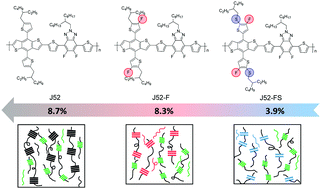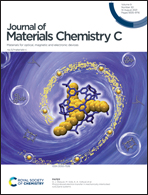Optimized active layer morphology via side-chain atomic substituents to achieve efficient and stable all-polymer solar cells†
Abstract
All-polymer solar cells (all-PSCs), consisting of conjugated polymers for both electron donors and acceptors, are promising photovoltaic candidates owing to their superior mechanical properties and long-term stability in addition to tunable light absorption and energy levels of the photoactive materials. One of the critical limitations to the device performance of all-PSCs is the non-ideal bulk-heterojunction morphology. Herein, we report the manipulation of active layer morphology for producing efficient all-PSCs based on a set of polymer donors (J52, J52-F, and J52-FS) with identical conjugated main chains but different side-chain atomic substituents. When blended with a state-of-the-art polymer acceptor NOE10, J52 provided a power conversion efficiency (PCE) of up to 8.7%, whereas J52-FS afforded a low PCE of 3.9%. The nano-spectroscopic imaging of the blend films revealed that the domain size in them is closely related to the device efficiency, and the highest PCE of the J52:NOE10 blend was contributed by its smallest domain size. The formation of different active layer morphologies was further explained by the Flory–Huggins interaction parameter. In addition, benefiting from the high miscibility of donors and acceptors, the J52:NOE10 devices achieved higher storage stability and thermal stability. These findings will aid in morphology optimization for high-performance all-PSCs.



 Please wait while we load your content...
Please wait while we load your content...